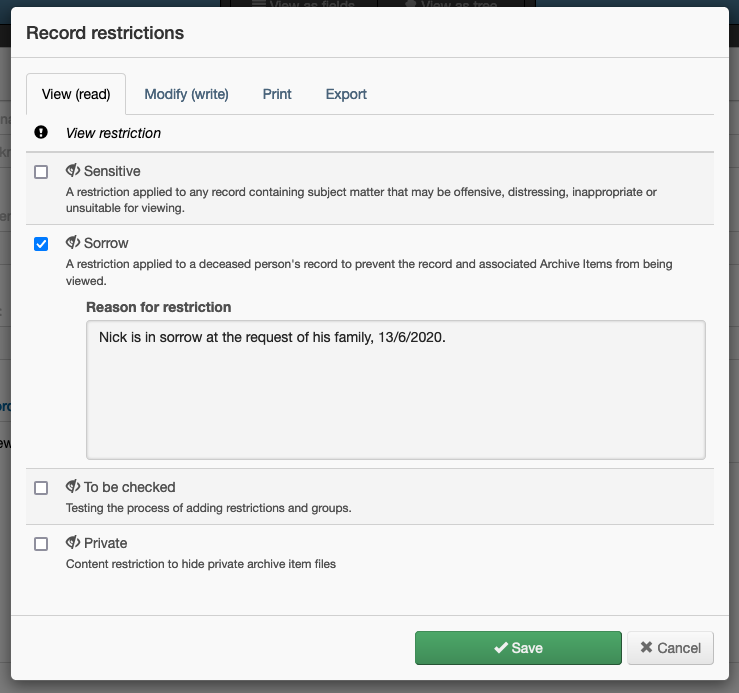Introduction
The process of applying restrictions to records is quite straight forward, however the archive has been designed with some special behaviour that you need to be aware of.
Here is what you need to know:
- You can only apply content restrictions that your User account has permission to access.
- Content restrictions can be used to control the user’s ability to View (read), Modify (write), Print and Export a record. Importantly, the View (read) restriction will prevent the record from being accessed, this also means the record cannot be modified, printed, or exported.
- Photos, Documents, Movies, Sounds and Objects classes can have restrictions placed on both the Item and/or View records, but the restriction behaviour will have a different effect on Items with multiple pages, tracks, clips or viewpoints.
- Placing a restriction on the Item record will apply to the Item record and all the associated View records. However, placing a restriction on the View record will restrict that View record alone. This means you can restrict a single page of a multi-page document leaving the other pages unrestricted.
- If an Archive Item has only one View, then it does not matter where the restriction is applied; it will result in the whole Item being restricted.
- Sorrow is a special system content restriction that can only be applied to People records. People records can have other content restrictions as well, but Sorrow’s usage is limited to just the People class.
- Some attributes (fields) can pass along the View (read) restrictions of the record it references to the record being viewed. When the archive assesses whether a User has Permission to access a record, both the restrictions on the record being viewed and the referenced record are dynamically evaluated together to determine if the User has the necessary permissions to access the record.
- This process is called ‘Amalgamating restrictions’. It is used with Features identified in Archive Item classes, the Contributor of recorded Annotations and the Creator attribute (field) in Sound items.
- This is important to remember, because a record can be restricted without having any restrictions on the record itself. In this situation, you will need to look at what records are being referenced; usually it’s a Feature that is restricting the record.

Restricting Archive Item and View records
- Conduct a search that will retrieve the Archive Item record to restrict.
- Display the record in the View page. In the metadata column on the right-hand side of the page, do one of the following:
- If you are restricting the whole Item, click the Item tab and scroll to the bottom to reveal the Archive Item restrictions control. Click Edit.
- If you are restricting a single View, click the View tab and scroll to the bottom to reveal the Archive View restrictions control. Click Edit.
- In the restrictions window, the content restrictions available to your account will be listed in each of the four tabs. Choose the tab appropriate to how you wish to apply the restriction, either View (read), Modify (write), Print or Export.
- Enable the checkbox for the restriction you wish to apply and enter the reason into the Reason for restriction textbox. If appropriate, repeat this step with any other restrictions you are applying or apply your restriction in the other tabs.
- Click Save. If you haven’t previously accepted the permissions applied to the record, then you will be asked whether you want to view the record you’ve just restricted.
Restricting Knowledge class records
- Conduct a search that will retrieve the Knowledge class record to restrict.
- Display the record in the View page.
- Scroll to the bottom of the page to reveal the Record Restrictions control. Click Edit.
- In the Record restrictions window, the content restrictions available to your account will be listed in each of the four tabs. Choose the tab appropriate to how you wish to apply the restriction, either View (read), Modify (write), Print or Export.
- Enable the checkbox for the restriction you wish to apply and enter the reason into the Reason for restriction textbox. If appropriate, repeat this step with any other restrictions you are applying or apply your restriction in the other tabs.
- Click Save. If you haven’t previously accepted the permissions applied to the record, then you will be asked whether you want to view the record you’ve just restricted.
How to restrict an Archive Item with Sorrow
The Sorrow restriction can only be applied to a Person record. Therefore, you need to apply the Sorrow restriction using the steps described in Restricting Knowledge class records to the record of the person who is deceased.
Any Photo, Document, Movie or Object records where the deceased has been identified in Features, or the deceased has been listed as a Creator of a Sound item, these records will automatically become restricted with Sorrow. However, if you have not applied Features identifying the deceased or added the deceased as a Creator of Sounds, then you must do this for the Sorrow restriction to be applied to Archive Item records.
See Applying Features.
Removing restrictions from records
The process of removing a restriction is similar to the process of adding a restriction. Instead of enabling the checkbox of the restriction, you would de-select the checkbox to remove the restriction. If this is unclear, see Restricting Knowledge class records and/or Restricting Archive Item and View records.
